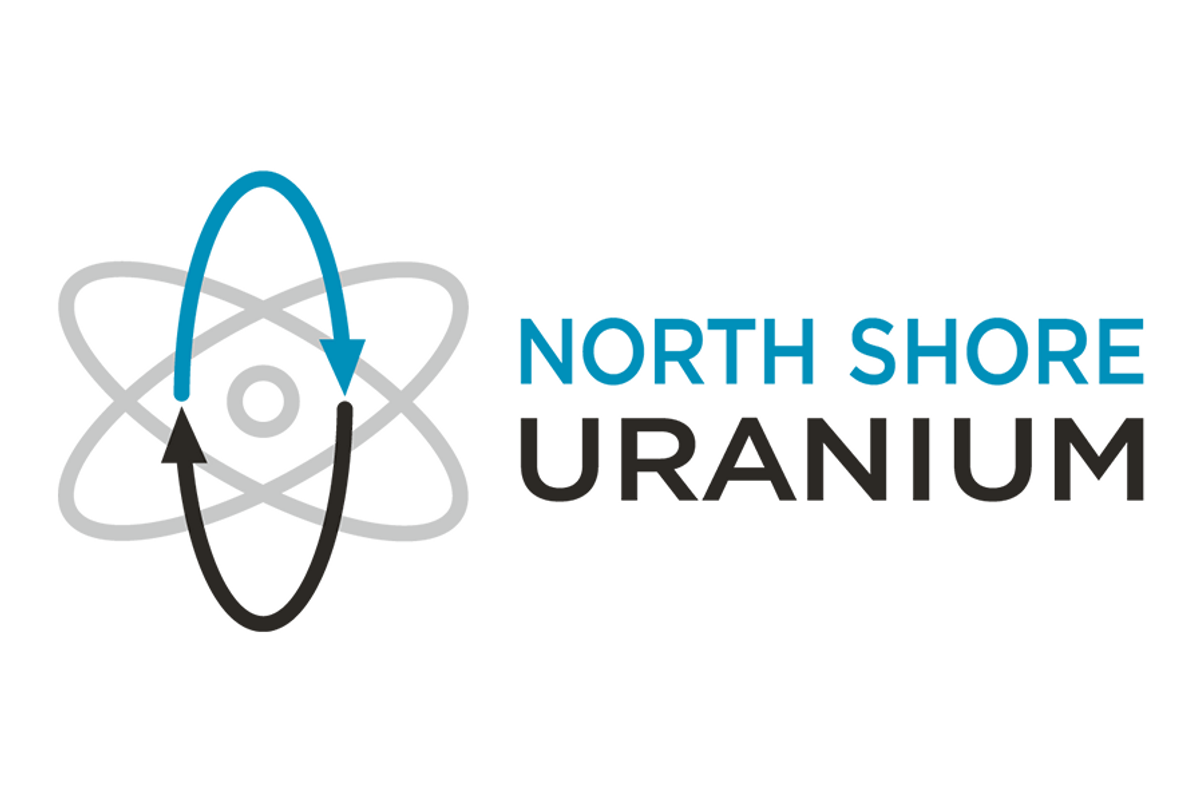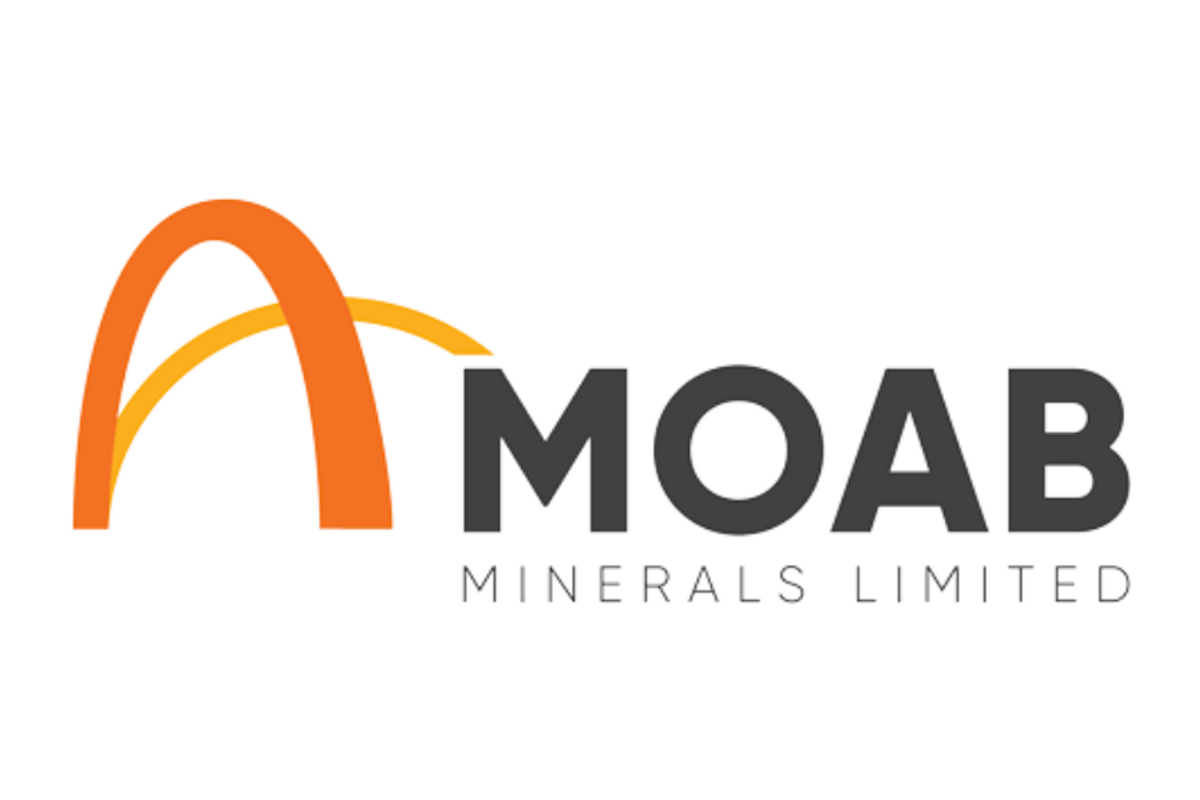
September 02, 2024
Moab Minerals Limited (ASX: MOM) (Moab or the Company) is pleased to provide an update of activities at the Manyoni Uranium Project in Tanzania, Africa.
Highlights:
- An extensive core drilling program (60 holes) has commenced at the Manyoni Uranium Project.
- Objective of 60-hole Stage One drilling is to verify historical drill results, obtain additional geologic and bulk density information, and carry out preliminary metallurgical test-work to ascertain the optimum processing pathway for the project.
- Strategically located just 5km north of Manyoni town, the Manyoni Uranium Project enjoys convenient access to modern railway and sealed highway infrastructure, as well as readily available power and water resources.
- The Manyoni Uranium Project was previously explored, and extensively drilled, by Uranex Ltd from the early 2000’s until 2013. The project did not proceed due to the low price of uranium at that time.
- Mineral Resource Estimation will be carried out by Snowdens/Optiro following successful completion of the Stage One program.
- Phase two drilling, involving a further 100 holes, will follow on and is designed to locate extensions to the known mineralisation at Manyoni.
Moab Managing Director, Mr Malcolm Day, commented: “I visited the Manyoni Uranium Project last week and am excited to report that drilling has started. The Company only settled the transaction on 9th July and in less than two months has been able to ‘hit the ground running’. The drilling program is expected to run over the next few months with most of the assay results available in November/December. I look forward to updating shareholders in coming months in regard the advancement of the Manyoni Uranium Project”.
About the Manyoni Uranium Project
Tanzania Uranium Projects (Moab 94.00%)
On 12 March 2024, the Company announced the acquisition of a package of advanced uranium projects in Tanzania (refer ASX Announcement 12 March 2024) (Acquisition). The Company completed the Acquisition on 9 July 2024.
The Acquisition includes the Manyoni and Octavo Uranium Projects, covering a total of 216 km2. The projects are strategically located just 5km north of Manyoni town, the Manyoni Uranium Project enjoys convenient access to modern railway and sealed highway infrastructure as well as readily available power and water resources.
The Manyoni Uranium Project was previously explored, and extensively drilled, by Uranex Ltd from the early 2000’s until 2013.
Project Location
The Manyoni Uranium Project tenements are located in the Republic of Tanzania (pop. 65 million), Africa, approximately 100km northwest of the capital city of Dodoma (pop. 765,000). The location of the uranium project at Manyoni is shown in Figure 1 and Figure 2.
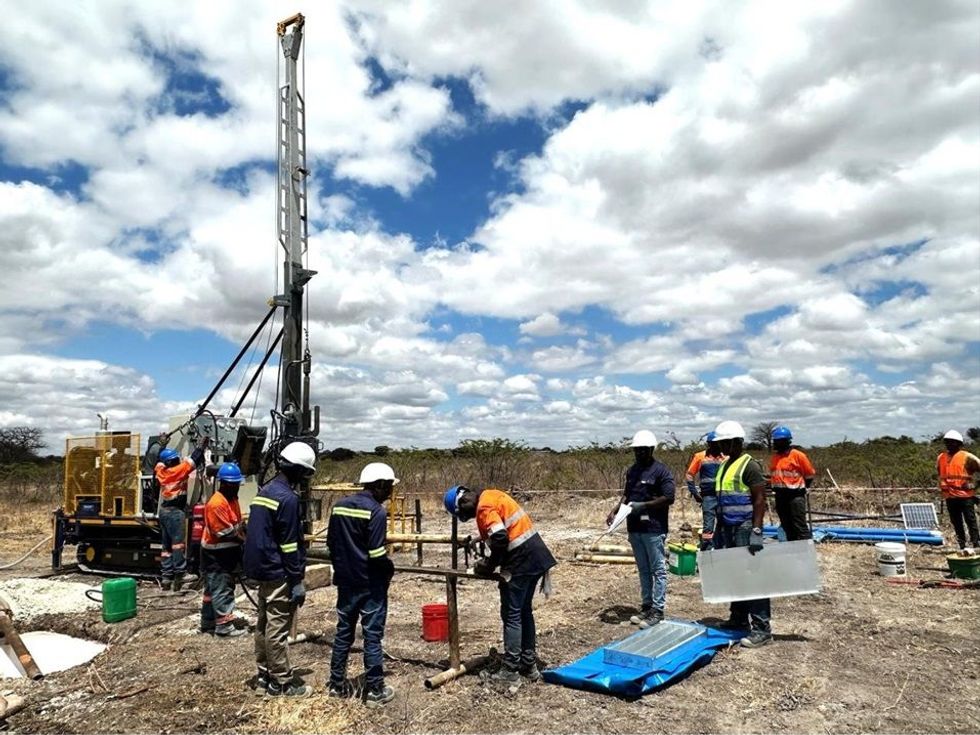
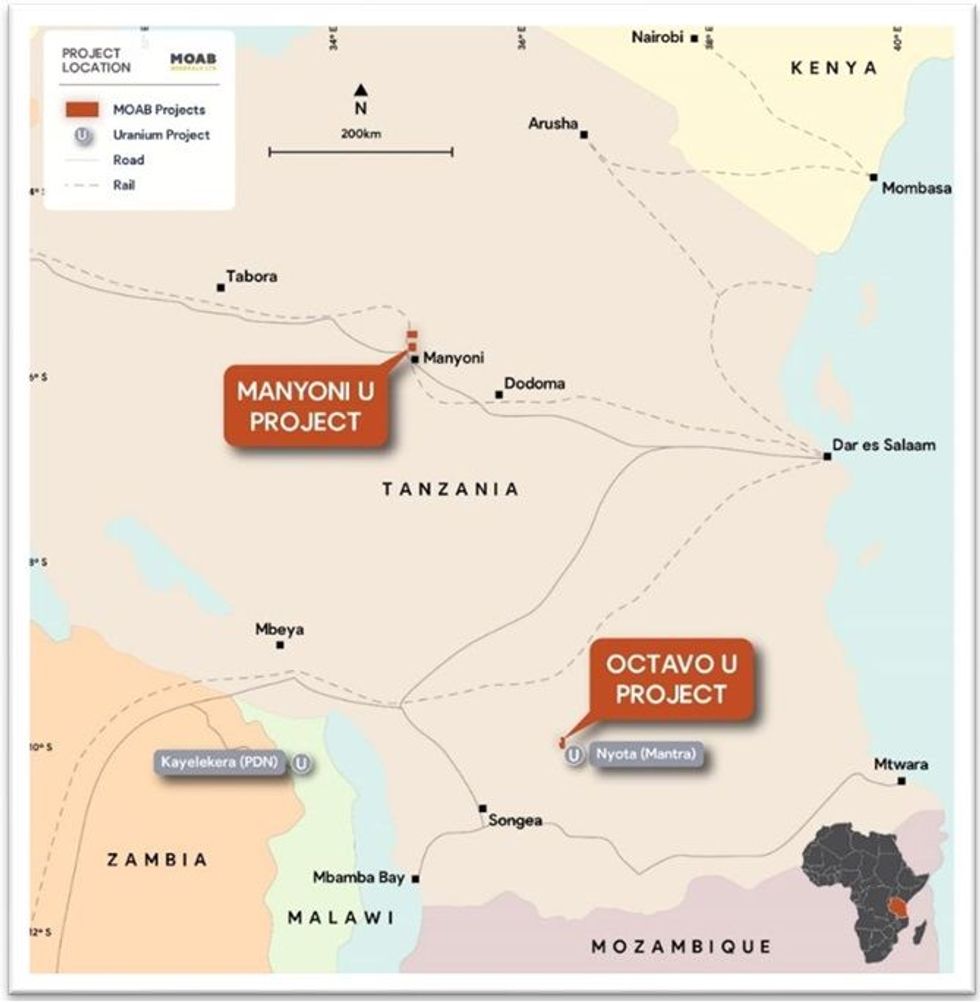
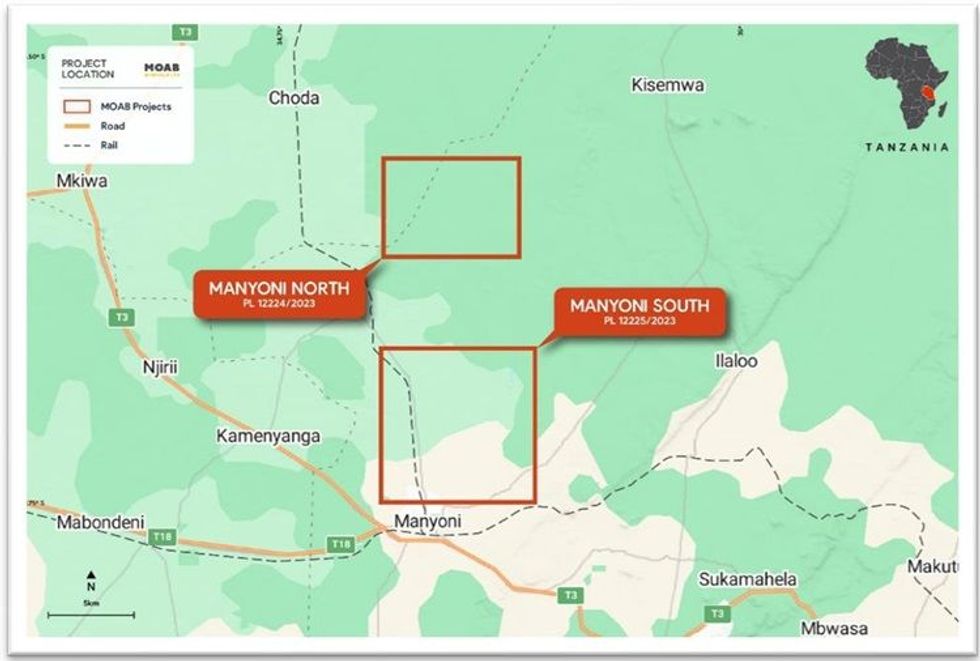
Geological Setting and Uranium Mineralisation
The tenements are located in the central part of the Tanzanian Archaean Shield, which is a stable platform of granite-gneiss terrane with marginal greenstone belts. Radiometrically “hot” granites have been subject to erosion over geological time and have contributed uranium and other metals into the pluvial streams and lakes which drain the shield.
In the Manyoni area the uranium is deposited in a shallow playa lake system as schröckingerite (in the lake sediments) and carnotite in the granitic saprolite below the lake sediments. The mineralisation varies from flat lying to shallowly dipping as it follows the direction of the palaeo- drainage to the south-east while the average depth to the top of mineralisation varies from 3m to 10m.
Validation Drilling (Stage One Drilling)
Moab has completed a substantial review of historic databases that were acquired from the property vendors. Moab has appointed Resource specialists Datamine/Optiro to assist the Company with planning a program of Validation drilling designed to verify historical drill results. A program of 60 drill holes involving PQ Triple Tube core drilling adjacent to old drill holes that contained uranium mineralisation is planned to commence in the 1st Quarter FY2024/2025. The objectives of the program include:
- Twinning of a statistically valid number of drill holes which provides the highest core recovery and sample quality. An estimated 60 drill holes to an average depth of 15m are planned. This program is designed to address historical assay reliability.
- Strict QA/QC controls will be implemented so as to provide a statistically valid means of verifying uranium grades.
- Bench scale metallurgical test work on a representative suite of bulk samples from the above drill program.
- Additional bulk density measurements to verify historical records and to expand the database for different mineralized domains.
- Improved understanding of the geological controls on uranium grade distribution.
It is estimated that this initial program will be completed in 2nd Quarter FY2024/2025. On completion of the Validation drilling program the information will be used to update the wire-frame model for mineralized domains thereby facilitating resource estimation, depending on results.
Exploration Drilling (Stage Two Drilling)
In addition to the above drilling, Moab is planning to undertake an exploration drilling program that is designed to locate extensions to the known mineralisation at Manyoni. This will be based on grid drilling on a 400m x 400m and 200m x 200m pattern around the known mineralisation. The Manyoni uranium mineralisation is at shallow depth, varying from 3m to 15m to the top of mineralisation, and flat lying. Moab has executed a drilling contract for a minimum of 1500m of PQTT core drilling covering Stages one and two drilling, with the option to drill an additional 1500m.
Click here for the full ASX Release
This article includes content from MOAB Minerals, licensed for the purpose of publishing on Investing News Australia. This article does not constitute financial product advice. It is your responsibility to perform proper due diligence before acting upon any information provided here. Please refer to our full disclaimer here.
MOM:AU
The Conversation (0)
24 March
Uranium Assay Results for Manyoni Uranium Project
18 February
Outstanding Uranium Assay Results at Manyoni Uranium Project
29 January
Quarterly Activities Report and Appendix 5B
08 December 2024
Manyoni Uranium Project - Validation Drilling Completed
3h
Exploration for Rare Earths to commence at Myoff Creek
22h
Company Update - Name Change to 'American Uranium Limited'
10 July
Terra Clean Energy Ramps Up Summer Drilling Plans, Eyes Resource Update
Terra Clean Energy (CSE:TCEC,OTCQB:TCEFF,FWB:C9O0) President and CEO Greg Cameron outlines the company's upcoming summer drill program at the South Falcon East uranium project, building on strong results from a winter campaign at the Fraser Lakes B deposit.
“The plan is to get up to 2,500 meters back into this new area of interest. Hopefully drill into what we're defining as an unconformity basement-hosted uranium deposit with significantly higher grade than we currently have,” he said.
“We would have the ability to update that resource report in some fashion, maybe early 2026 or mid-2026, so those are the two key catalysts. But it's all about drilling and adding pounds to the current resource and, more importantly, significantly enhancing that grade which we think we have," Cameron added.
The 2025 summer drill program will target a priority zone identified in the winter campaign, where key geological features associated with high-grade uranium converge, further presenting a strong opportunity for high-grade discovery and resource expansion.
Watch the full interview with Terra Clean Energy president and CEO Greg Cameron above.
Keep reading...Show less
10 July
Placement Shares Issued & Drilling Approval Expected August
09 July
Top 3 ASX Uranium Stocks of 2025
Uranium broke out in 2024, with the spot price rising to a 17 year high of US$106 per pound early in the year. Despite a pullback to about US$78, uranium is still more than 40 percent higher than it was two years ago.
Although the market is dealing with ample supply and uncertain demand in 2025, experts are predicting a bright future as countries around the world pursue energy security goals.
Against that backdrop, ASX-listed uranium companies have been making moves in 2025.
Below the Investing News Network has listed the top-performing uranium shares on the ASX by year-to-date gains. Data was gathered using TradingView's stock screener on July 3, 2025, and Australian uranium companies with market caps above AU$10 million at the time were considered. Read on to learn more about uranium firms and what they've been up to so far this year.
1. Boss Energy (ASX:BOE)
Year-to-date gain: 72.02 percent
Market cap: AU$1.84 billion
Share price: AU$4.18
Boss Energy is one of Australia’s largest uranium mining companies by market cap. The company has been ramping up production at its Honeymoon uranium mine in South Australia and its Alta Mesa uranium mine joint-venture in South Texas. Boss Energy holds a 30 percent stake in Alta Mesa, with the remaining 70 percent owned by enCore Energy (TSXV:EU,NASDAQ:EU).
So far in 2025, Boss Energy has expanded its holdings in Australia’s uranium sector. The company entered into a binding option and earn-in agreement in early March with Eclipse Metals (ASX:EPM), which will grant Boss Energy the option to earn up to an 80 percent interest in the Liverpool uranium project in the Northern Territory.
A few days later, Boss Energy increased its position in Laramide Resources (ASX:LAM,TSX:LAM,OTCQX:LMRXF) to 18.4 percent. Laramide’s flagship asset is the Westmoreland uranium project in Queensland. While the state currently holds a moratorium on uranium mining, Boss Energy Managing Director Duncan Craib stated the company is confident the Queensland government will “inevitably lift” the ban.
The company announced on June 18 that it had met its first-year production guidance of 850,000 pounds of U3O8 at Honeymoon for the fiscal year 2025.
Shares of Boss Energy reached their 2025 peak on June 30 at AU$4.67.
2. Aura Energy (ASX:AEE)
Year-to-date gain: 24 percent
Market cap: AU$146.04 million
Share price: AU$0.16
Aura Energy is exploring and developing uranium and polymetallic projects in Africa and Europe. The company’s most advanced asset is the Tiris uranium project in Mauritania. The 2024 FEED study on Tiris demonstrates the potential for a near-term, low-cost uranium mine producing 2 million pounds of U3O8 per year over a 25 year mine life.
Aura Energy is hoping to bring the Tiris uranium mine into production in 2027.
Additionally, Aura wholly owns the Häggån vanadium-potash-uranium project in Sweden, which contains one of the world's largest uranium deposits, according to the company. Sweden currently has a ban on uranium mining, but the country's current government is taking steps towards lifting it to support the country's nuclear energy production.
In early June, Aura shared that it is holding discussions with the Swedish government and entered a strategic collaboration agreement with fellow Australia-based, Sweden-focused company Neu Horizon Uranium.
Shares of Aura Energy hit a year-to-date high of AU$0.18 twice so far this year, most recently on June 30. This followed the June 26 release announcing the publishing of the Environmental and Social Impact Assessment on the US International Development Finance Corporation website. Aura applied to the organization for debt financing to cover a portion of development costs for Tiris.
3. Elevate Uranium (ASX:EL8)
Year-to-date gain: 16.98 percent
Market cap: AU$119.54 million
Share price: AU$0.31
Elevate Uranium is exploring and developing uranium projects in the top uranium producing nations of Namibia and Australia. Its project pipeline includes the Koppies and Marenica projects in Namibia, and the Minerva and Angela projects in Australia.
Koppies is its most advanced project and has a near-surface resource of 66 million pounds of U3O8.
Elevate has also developed the proprietary U-pgrade beneficiation process, which reduces ore mass by greater than 95 percent prior to leaching. This results in concentrated uranium with grades of about 10,000 parts per million uranium.
The company’s presentation released in mid-June outlines that its U-pgrade demonstration plant at the Koppies project will be operational by the end of 2025. Additionally, The company plans to begin a project study at Koppies in late 2025.
Shares of Elevate Uranium reached their 2025 peak on June 18 at AU$0.35.
Don’t forget to follow us @INN_Australia for real-time updates!
Securities Disclosure: I, Melissa Pistilli, hold no direct investment interest in any company mentioned in this article.
Keep reading...Show less
09 July
North Shore Uranium Engages Investing News Network
North Shore Uranium Ltd. (TSX-V:NSU) ("North Shore" or the "Company") is pleased to announce that it has entered into an advertising and investor awareness campaign agreement (the "INN Agreement") with Dig Media Inc. dba Investing News Network ("INN").
INN is a private company headquartered in Vancouver, Canada, dedicated to providing independent news and education to investors since 2007 at www.investingnews.com. On July 4, 2025, the Company entered into the INN Agreement. The INN Agreement will be for a three-month term, with three equal payments of $2,750 that will be paid at the beginning of each month, totaling $8,250 (GST excluded). The INN Agreement will not automatically renew. INN will provide advertising to increase awareness of the Company with the first campaign commenced on July 4, 2025. INN does not provide Investor Relations or Market Making services. INN currently holds no common shares in the Company. INN and the Company are unrelated and unaffiliated entities.
The INN Agreement is subject to approval by the TSX Venture Exchange.
ABOUT NORTH SHORE
The nuclear power industry is in growth mode as more nuclear power will be required to meet the world's ambitious CO2 emission-reduction goals and the needs of new power-intensive technologies like AI. In this environment, new discoveries of economic uranium deposits will be very valuable, especially in established uranium-producing jurisdictions like Saskatchewan and New Mexico (see news release dated June 24, 2025). North Shore is well-positioned to become a major force in exploration for economic uranium deposits. The Company is working to achieve this goal by exploring its Falcon and West Bear properties at the eastern margin of the Athabasca Basin in Saskatchewan, expanding its exploration efforts to include the Grants Uranium District in New Mexico and by evaluating other quality opportunities in the United States and Canada to complement its portfolio of uranium properties. North Shore summarized exploration efforts at its Falcon property in a May 27, 2025, news release.
ON BEHALF OF THE BOARD
Brooke Clements,
President, Chief Executive Officer and Director
For further information:
Please contact: Brooke Clements, President, Chief Executive Officer and Director
Telephone: 604.536.2711
Email: b.clements@northshoreuranium.com
www.northshoreuranium.com
Neither the TSX Venture Exchange nor its Regulation Services Provider (as that term is defined in the policies of the TSX Venture Exchange) accepts responsibility for the adequacy or accuracy of this release.
Forward-Looking Statements
This news release contains forward-looking statements that are based on the Company's current expectations and estimates. Forward-looking statements are frequently characterized by words such as "plan", "project", "appear", "interpret", "coincident", "potential", "confirm", "suggest", "evaluate", "encourage", "likely", "anomaly", "continuous" and variations of these words as well as other similar words or statements that certain events or conditions "could", "may", "should", "would" or "will" occur. Such forward-looking statements involve known and unknown risks, uncertainties and other factors that could cause actual events or results to differ materially from estimated or anticipated events or results implied or expressed in such forward-looking statements. Such factors include, among others: the completion of the Offering; the completion and expected terms of the Transaction, the parties' abilities to meet the closing conditions of the Transaction, the number of securities to be issued by the Company in connection with the Transaction, receipt of all necessary approvals for the completion of the Transaction, the completion of satisfactory due diligence, execution of a definitive agreement, and the Company's ability to meet the terms of the Transaction; the highly speculative nature of the Transaction given the early-stage nature of Rio Puerco; the actual results of current and planned exploration activities including the potential for the definition of a mineral deposit of potential economic value at the Company's Falcon property in Saskatchewan; that drilling results, geophysical survey results and/or interpretations thereof are defining potentially mineralized corridors; results from future exploration programs including drilling; interpretation and meaning of completed and future geophysical surveys; conclusions of future economic evaluations; changes in project parameters as plans to continue to be refined; possible variations in grades of mineralization and/or future actual recovery rates; accidents, labour disputes and other risks of the mining industry; the availability of sufficient funding on terms acceptable to the Company to complete the planned work programs; delays in obtaining governmental approvals or financing; and fluctuations in metal prices. There may be other factors that cause actions, events or results not to be as anticipated, estimated, or intended. Any forward-looking statement speaks only as of the date on which it is made and, except as may be required by applicable securities laws, the Company disclaims any intent or obligation to update any forward-looking statement, whether as a result of new information, future events, or results or otherwise. Forward-looking statements are not guarantees of future performance and accordingly undue reliance should not be put on such statements due to the inherent uncertainty therein. Any forward-looking statements contained in this news release are expressly qualified in their entirety by this cautionary statement.
Click here to connect with North Shore Uranium Ltd. (TSXV:NSU) to receive an Investor Presentation
Keep reading...Show less
Latest News
Latest Press Releases
Related News
TOP STOCKS
American Battery4.030.24
Aion Therapeutic0.10-0.01
Cybin Corp2.140.00





